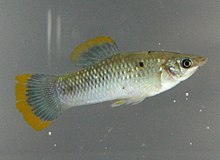| Revision as of 10:39, 1 September 2024 editSurtsicna (talk | contribs)Autopatrolled, Extended confirmed users130,758 editsNo edit summary← Previous edit | Revision as of 10:41, 1 September 2024 edit undoSurtsicna (talk | contribs)Autopatrolled, Extended confirmed users130,758 edits This is rather misleading as many if not all of these are hybrids and not just Poecilia sphenops. It needs to be rewritten with clarity - and sources.Next edit → | ||
| Line 41: | Line 41: | ||
| ===Size=== | ===Size=== | ||
| Standard size of male fish is 3.2″ (8 cm) and female fish is 4.8″ (12 cm). | Standard size of male fish is 3.2″ (8 cm) and female fish is 4.8″ (12 cm). | ||
| ===Varieties=== | |||
| ] over centuries has produced several color variations and different body shapes. | |||
| *'''Short-finned molly''' or '''common molly''': They inhabit fresh water streams and coastal brackish and marine waters of Mexico. The wild-type fishes are dull, silvery in color. The molly can produce fertile hybrids with many ''Poecilia'' species, most importantly the ]. The wild form is in fact quite rarely kept, as it has a rather plain silvery coloration suffused with brown and green hues. | |||
| *'''Black molly''': It is a ] breed which are black all over. It is one of the most well-known aquarium fishes and nearly as easy to keep and prolific as guppies. | |||
| *'''White molly''': A white colored molly. | |||
| *'''Golden molly''': Nicknamed the "24 ]". | |||
| *'''Balloon molly''': This fish has a deformed spine due to a genetic defect that gives it its appearance. Through ] it is now widely available. Balloon mollies can still reproduce and live a normal life comparable to that of other mollies, but it has garnered controversy due to the belief that its defect gives it a shortened lifespan and a susceptibility to health problems.{{Citation needed|date=November 2016}} | |||
| *'''Lyretail''': A breed with an altered caudal fin structure. | |||
| *'''Dalmatian molly''': A silver colored breed with black speckles. | |||
| == Gallery == | == Gallery == | ||
Revision as of 10:41, 1 September 2024
Species of livebearer fish
| Molly | |
|---|---|

| |
| Male molly | |
| Conservation status | |
 Least Concern (IUCN 3.1) | |
| Scientific classification | |
| Domain: | Eukaryota |
| Kingdom: | Animalia |
| Phylum: | Chordata |
| Class: | Actinopterygii |
| Order: | Cyprinodontiformes |
| Family: | Poeciliidae |
| Genus: | Poecilia |
| Species: | P. sphenops |
| Binomial name | |
| Poecilia sphenops (Valenciennes, 1846) | |
| Synonyms | |
| |
Poecilia sphenops is a species of fish, of the genus Poecilia, known under the common name molly; to distinguish it from its congeners, it is sometimes called short-finned molly or common molly. They inhabit fresh water streams, coastal brackish, and marine waters from Mexico to Colombia. The wild-type fishes are dull, silvery in color. The molly can produce fertile hybrids with many Poecilia species, most importantly the sailfin molly. The male mollies generally tend to be mildly aggressive.
Mollies rank as one of the most popular feeder fish due to high growth rate, birth size, reproduction, and brood number.
Biology
Mollies are similar in appearance to their livebearer cousins, the platy, swordtail and guppies; the molly tends to be slightly larger and more energetic. Many aquarists note the stronger individuality and aggression in keeping mollies versus platies, who appear much more docile.
Size
Standard size of male fish is 3.2″ (8 cm) and female fish is 4.8″ (12 cm).
Gallery
References
- Matamoros, W.A. (2019). "Poecilia sphenops". IUCN Red List of Threatened Species. 2019: e.T191753A2002434. doi:10.2305/IUCN.UK.2019-2.RLTS.T191753A2002434.en. Retrieved 19 November 2021.
- Froese, Rainer; Pauly, Daniel (eds.). "Poeclia sphenops". FishBase. August 2019 version.
- "Poecilia sphenops". Integrated Taxonomic Information System. Retrieved 30 January 2006.
- Froese, Rainer; Pauly, Daniel (eds.). "Poecilia sphenops". FishBase. October 2005 version.
- "Mollies Fish" Detailed information on raising the Molly fish. January 2022 version
| Taxon identifiers | |
|---|---|
| Poecilia sphenops | |
This Cyprinodontiformes article is a stub. You can help Misplaced Pages by expanding it. |


